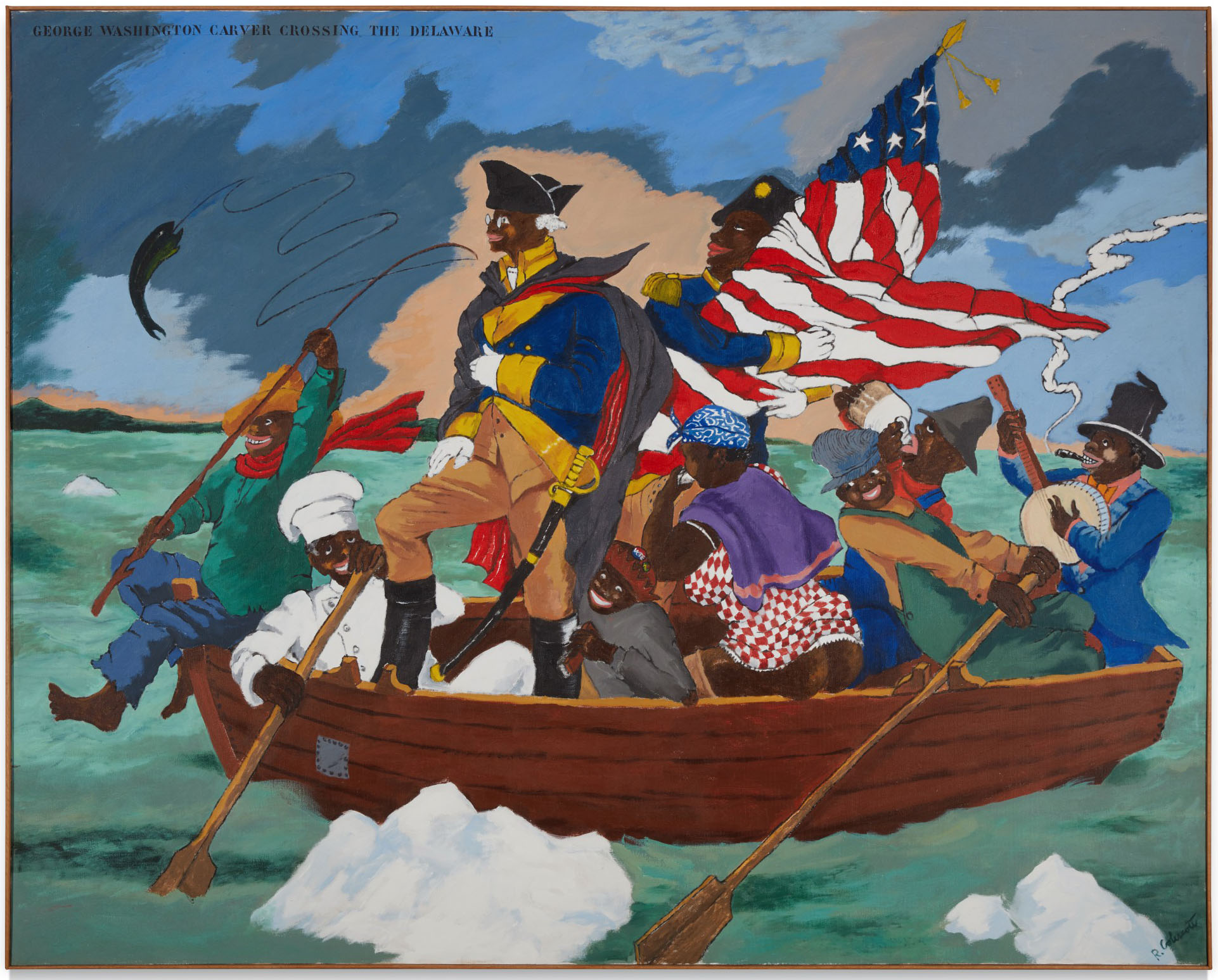Colescott Meets Leutze Meets 2022
 |
| Installation view of Robert Colescott's George Washington Carver Crossing the Delaware at the Metropolitan Museum, New York |
The Lucas Museum of Narrative Art, still several years from opening in L.A., has lent one of its marquee paintings to New York. Robert Colescott's George Washington Carver Crossing the Delaware (1975), purchased by the Lucas last year, is getting focus show treatment at the Metropolitan Museum of Art. It occupies a room adjacent to Colescott's source material, George Washington Crossing the Delaware (1851) by Emmanuel Leutze. If you stand in the right place you can see all of one and part of the other at the same time.
 |
| Robert Colescott, George Washington Carver Crossing the Delaware: Page from an American History Textbook, 1975. Lucas Museum of Narrative Art, Los Angeles |
 |
| Robert Colescott, Study for George Washington Carver Crossing the Delaware, 1974. Nene Humphrey Collection |
The Met installation presents a preparatory drawing by Colescott with fewer figures. George Washington Carver is given the attributes of a test tube and a bag of peanuts. There are fewer figures, and Carver faces away from the stereotypes.
 |
| Kara Walker, The Crossing, 2017. Collection of Neda Young |
Also on view is a large 2017 Kara Walker drawing, exhibited for the first time. Walker begun the drawing as a reaction to Donald Trump's inauguration. Washington/Carver is now Trump, wearing a paper hat and a mask. The composition melds Leutze and Colescott with Gericault's The Raft of the Medusa, John Singleton Copley's Watson and the Shark, and perhaps James Ensor's Christ's Entry into Brussels in 1889.
A gallery label further connects the Colescott and Walker to Winslow Homer's Gulf Stream, normally shown in this space. Lacking in most of those precedents, however, is a sense of the absurd. Colescott and Walker leapfrog Leutze to an older Old Master conceit, the ship of fools.
A democracy is guided by a clash of voices. America was founded on the hopeful premise that the wise and humane will ultimately prevail. We're about to see how well that plays out in 2022.

Comments
The photo of the partial Leutze reveals how vast it is...far too vast for that gallery's size. It sucks the air out of the room, and gravely detracts from the many other works in the space, including many great masterpieces of the American landscape tradition.
Maybe Lucas could be enticed to swap. Please!
> the many other works in the space
That's the impression I had in general of the many huge works displayed at the Louvre. That museum was admittedly very impressive and loaded down with stellar pieces, but it was also very baroque-gaudy and eventually overbearing.
The rebuilt, comparatively small LACMA with all its windows and views of cars driving down Wilshire Blvd will probably end up being the opposite extreme. But at least the few standouts in the museum's collection won't get lost the way such works get lost at the Louvre or Metropolitan.
The museum is a home converted to public use of a national collection, ammassed over five centuries.
There is not even a remote equivalent in America, so comparisons are out of order.
It's gaudy because it's authentically Baroque, so overbearingly appropriate to the time of its creation.
It's certainly overbearing if you expect to see it all in one vacation, let alone a lifetime of visits.
It's probably my favorite art venue of all. [Though the National Palace Museum in Taipei is right up there as well...although its collection has been amassed over 1,000 years, makking France's joint an arriviste.]
If I were a philanthropist and wanted to donate my prized possession to a museum, I know it would be quickly lost in (and not much appreciated by) the Louvre, whereas even the concrete overpass of LACMA might be a far more suitable new home for it.